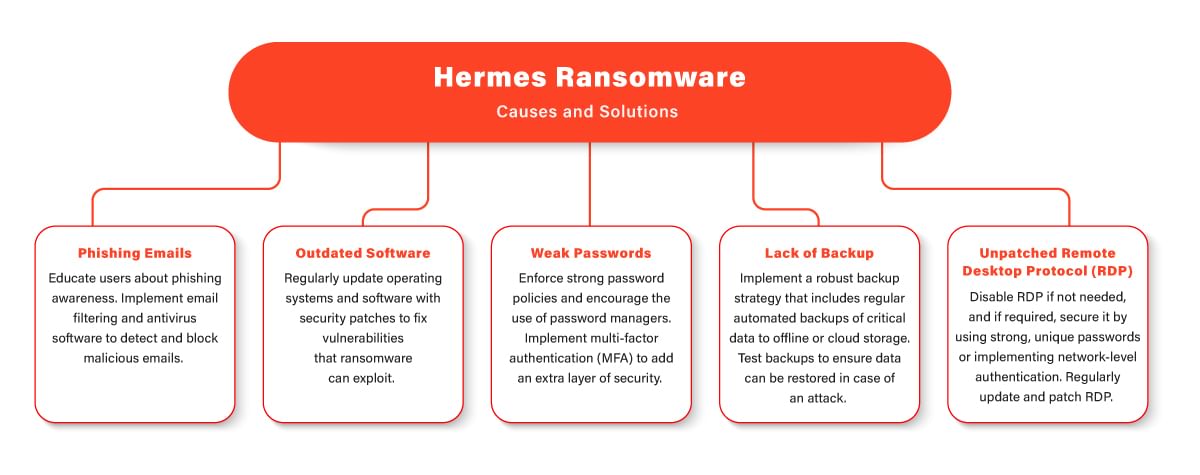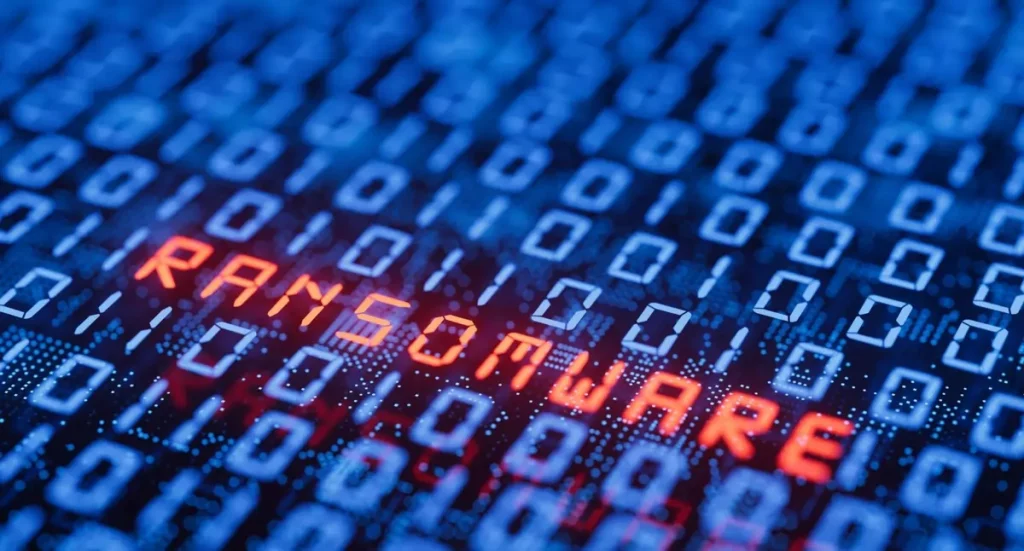In the ever-evolving landscape of cybersecurity threats, ransomware remains a formidable adversary. Among the multitude of ransomware strains, one that has been making waves in recent times is Hermes Ransomware. This insidious malware has wreaked havoc on countless individuals and organizations, encrypting their precious data and demanding hefty ransoms for its release. In this comprehensive blog post, we will delve into the depths of Hermes Ransomware, exploring its origins, attack methods, prevention strategies, and even peek behind the scenes to understand its encryption mechanism. By the end, you will have a clearer picture of this evolving threat and how to protect yourself against it.
What is Hermes Ransomware?
Hermes Ransomware, often stylized as “Hermes 2.1,” is a variant of ransomware that first emerged in the murky corners of the cybercriminal world. Named after the Greek god of transitions and boundaries, Hermes strikes a chord of ominous symbolism as it effectively traps its victims within a digital prison, demanding a ransom for their data’s safe release.
The Anatomy of a Ransomware Attack
Before we dive into the specifics of Hermes, let’s understand the common elements of a ransomware attack. These attacks typically follow a well-established pattern:
1.Infection: The attack begins when a user’s computer is infected with the ransomware. This can occur through various means, including malicious email attachments, infected downloads, or vulnerabilities in outdated software. In the case of Hermes, one common entry point is spam emails.

2.Encryption: Once the ransomware infects a system, it uses a sophisticated encryption algorithm to lock away the victim’s files. This encryption process renders the data inaccessible without the decryption keys.
3.Ransom Note: After encrypting the files, Hermes displays a ransom note, informing the victim that their data is encrypted and providing instructions on how to pay the ransom to obtain the decryption keys.
4.Ransom Payment: Victims are typically asked to pay the ransom in cryptocurrencies, making it harder to trace the perpetrators. The ransom amount can vary widely, and there is no guarantee that paying it will result in the safe return of the data.
5.Decryption: If the victim chooses to pay the ransom, they receive the decryption keys, allowing them to unlock their files. However, paying the ransom is strongly discouraged by law enforcement agencies and cybersecurity experts.
How to Prevent Hermes Ransomware Infections
Prevention is the best defense against ransomware attacks like Hermes. Here are some effective strategies to protect your data and systems from falling victim to this malicious software:
1
Educate Yourself and Your Team
Knowledge is the first line of defense. Educate yourself and your team about the risks associated with ransomware and how it can infiltrate your systems. Recognize the telltale signs of phishing emails, malicious attachments, and suspicious links.
2
Use Antivirus and Anti-malware Software
Deploy reputable antivirus and anti-malware software on all your devices. Ensure that the software is regularly updated to detect and remove threats, including ransomware variants like Hermes.
3
Keep Your Operating Systems and Software Updated
Outdated software and operating systems often have known vulnerabilities that cybercriminals exploit. Regularly update all software and operating systems to patch these vulnerabilities and reduce your exposure to attacks.
4
Implement Strong Email Security Measures
Spam emails are a common delivery mechanism for ransomware. Use email security solutions that filter out malicious emails and attachments. Train your employees to identify and report suspicious emails.
5
Backup Your Data
Regularly back up your data to secure, offline locations. Up-to-date backups can mitigate the impact of a ransomware attack, as you can restore your data without paying a ransom.
6
Monitor Network Traffic
Implement network monitoring solutions to detect unusual or suspicious network traffic patterns. Early detection can prevent the spread of ransomware within your network.

Hermes Ransomware: An Evolution of Threat
Hermes Ransomware has not remained stagnant; it has evolved to become more sophisticated and elusive. Here are some notable aspects of its evolution:
- Version Upgrades
Hermes has seen several iterations, each more advanced than the last. The ransomware becomes more adept at evading detection and encryption with each version upgrade. New encryption algorithms and evasion techniques are regularly incorporated into these updates.
- Increased Targeting
Initially, Hermes primarily targeted individual users. However, it has shifted its focus towards organizations and businesses. High-profile targets, such as healthcare institutions and government agencies, have fallen victim to this ransomware.
- Ransom Demands
The ransom demands associated with Hermes Ransomware have also increased over time. Attackers recognize the potential value of encrypting critical business data, leading to more significant demands for decryption keys.
- Multi-language Support
To broaden its reach and target a more global audience, Hermes now supports multiple languages in its ransom notes and communication with victims. This makes it accessible to a wider range of potential targets.
- Evading Detection
Hermes has become adept at evading detection by security software and sandboxes. It employs anti-analysis techniques to thwart researchers and security professionals trying to reverse-engineer the malware.
- Affiliate Programs
Some versions of Hermes Ransomware have adopted affiliate programs, allowing other cybercriminals to distribute the malware in exchange for a share of the ransom payments. This has contributed to its widespread distribution.
In the ever-changing landscape of cybersecurity threats, Hermes Ransomware stands out as a particularly menacing adversary. Its evolution from a simple ransomware strain to a sophisticated and highly targeted threat underscores the need for robust cybersecurity measures.
Prevention remains the most effective strategy against Hermes and similar ransomware variants.

Educating yourself and your team, implementing strong email security, and maintaining up-to-date backups are essential steps in safeguarding your data. Remember that paying the ransom is a risky endeavor and is discouraged by cybersecurity experts and law enforcement agencies.
As Hermes Ransomware continues to evolve, so must our defenses. By staying informed and adopting proactive cybersecurity practices, we can better protect ourselves and our organizations from falling victim to this insidious threat.
Data Recovery after Hermes Ransomware with PITS
In cybersecurity, organizations must prioritize prevention and prepare for the worst-case scenario. Coping with the consequences following a successful Hermes Ransomware attack can lead to severe repercussions, leaving organizations without access to critical data. This is precisely where ransomware data recovery solutions come into play.

If you’re facing a data loss situation, don’t hesitate to contact us. Our 24/7 data recovery services are available to you, 365 days a year. Let us help you recover your precious data today.

We start the recovery process with a risk-free evaluation. Our technicians estimate reasons for data loss and the level of damage. Based on it, we select the most suitable recovery strategy.

With years in the data recovery industry, our company supports the highest customer satisfaction rate. We do everything to provide a positive experience for our clients.

During our remote customer file verification session, you will thoroughly review all necessary documents and records to ensure accuracy and compliance.

We offer data recovery services from over 50 locations across the US. This means that no matter where you are located, you can access our services to recover the data.

With our certified data recovery services and 99% success rate, we are confident that we can recover your precious data and get you back up and running in no time.
Our specialized data recovery company is fully committed to assisting organizations in the aftermath of Hermes Ransomware attacks. Supported by a team of experienced professionals and state-of-the-art technology, our primary goal is to help organizations regain access to their encrypted data and swiftly restore operational stability.
Hermes Ransomware poses a significant threat to both organizations and individuals due to its combination of file encryption and data exposure. To defend against such attacks, a comprehensive strategy encompassing security awareness, proactive defenses, and incident response plans is essential.
Frequently Asked Questions
What is Hermes Ransomware?
Hermes Ransomware is a type of malicious software (malware) that encrypts your computer files and demands a ransom for their decryption. It essentially holds your data hostage until you pay a fee to the cybercriminals behind the attack.
How does Hermes Ransomware infect my computer?
Hermes Ransomware often infects computers through phishing emails, malicious attachments, or by exploiting vulnerabilities in outdated software. Clicking on suspicious links or downloading infected files can lead to an infection.
Can I decrypt my files without paying the ransom?
Decrypting files encrypted by Hermes Ransomware without the decryption keys is extremely difficult. It is generally not recommended to pay the ransom, as there is no guarantee that you will receive the decryption keys or that your files will be restored.
How can I protect my computer from Hermes Ransomware?
To protect your computer from Hermes Ransomware, you should regularly update your software and operating system, use reliable antivirus software, be cautious with email attachments and links, back up your data regularly, and avoid downloading files from untrustworthy sources.
What should I do if my computer is infected with Hermes Ransomware?
If your computer is infected with Hermes Ransomware, it’s crucial not to pay the ransom. Disconnect your computer from the network to prevent the malware from spreading. Contact a cybersecurity professional for guidance on how to remove the ransomware and explore potential options for data recovery, such as restoring from backups.
